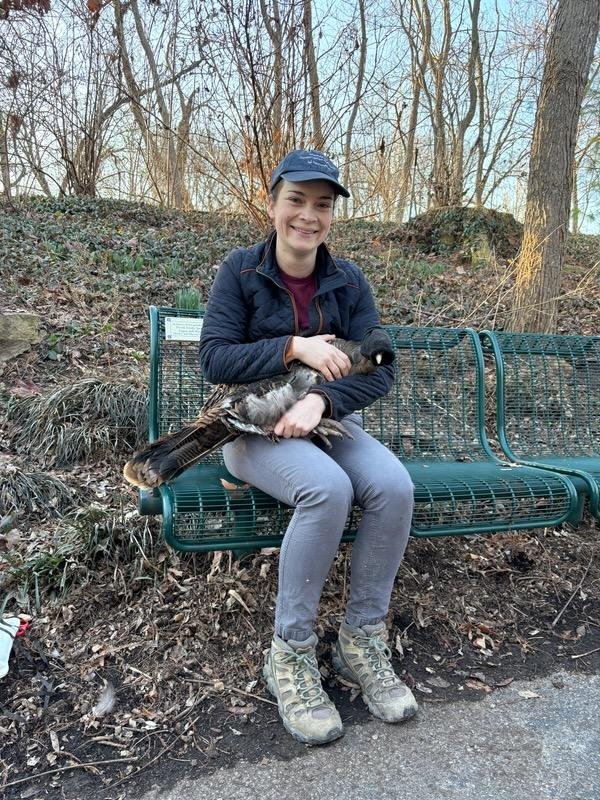Through fair and fowl weather, we added Regina the turkey to the study!
Carefully holding Regina before her health evaluation.
Turkeys are a familiar bird species in Missouri and are commonly seen in Kennedy Woods in the southwest corner of the Forest Park. We have been hard at work to add this species to our study! For a few months, we have been using motion-triggered wildlife cameras and word of mouth to understand where Forest Park’s turkeys tend to gather. It seems that they like being at the zoo along with us humans! After spending many chilly mornings trying to trap a turkey, we successfully captured a female turkey, “Regina”, on zoo grounds. Regina received a full physical exam, and we collected swabs and other samples for further testing. We then fitted her with a GPS tag so we can collect data on her location and activity in the park.
Dr. Deem and Dr. Uiterwaal carry Regina from the turkey trap for her health evaluation.
Let’s Gobble Up Some Facts about Wild Turkeys
Wild turkeys, or Meleagris gallopavo, live in open woodlands and commonly reside in large flocks. They typically roost high up in trees. You can differentiate male and female turkeys by both their size (males are larger than females) and their coloration, or feathers (males have a red and blue head with a fanned tail, while females have a longer neck and legs and are dark brown overall with even darker barring).
Turkeys snacking on some cracked corn, seen in a camera trap photo. Camera traps help us monitor wildlife activity.
Turkeys are found year-round in 49 out of 50 states (excluding Alaska), and parts of Mexico and Canada. They are found statewide in Missouri. These birds are omnivorous ground foragers with food sources including grass seeds, dogwood fruits, wild grapes, corn, oats, and wheat with acorns as prominent food sources in the winter. Insects are important food sources for the growth of the young birds. Turkeys forage by scratching in the leaves beneath hedgerows and in forests (Missouri Department of Conservation, 2024).
Fun Fact: the name turkey may have originated by the English from early shipping routes that passed through the country of Turkey to deliver the birds to European markets (McRoberts et al., 2020).
A flock of turkeys outside the Saint Louis Zoo.
What is the human impact on wild turkeys?
Free-living turkey populations were noted to be decreasing in the early 20th century, likely due to their popularity as gamebirds. To counter this, turkeys were transplanted (captured and transported to other areas), establishing populations in several US states and in parts of southern Canada (McRoberts et al., 2020). By tracking turkey movement, we get a better understanding of turkeys in cities today.
Not just chickens cross the road. Turkeys do too! Three turkeys crossing a road in Forest Park. Tracking turkeys with GPS tags helps us understand the impacts of human structures on wildlife
Interested in keeping up with Regina’s movements? Check out the data on Movebank or see animated locations on the Animal Tracker App.
Yellow dots show Regina’s locations over the first six weeks of tracking her.
By Sarah Look, Saint Louis Zoo Institute for Conservation Medicine intern.
References
McRoberts, J.T., Wallace, M.C., Eaton, S.W., 2020. Wild Turkey (Meleagris gallopavo), version 1.0. Birds of the World. https://doi.org/10.2173/bow.wiltur.01species_shared.bow.project_name
Missouri Department of Conservation, 2024. Wild Turkey. Mo. Dep. Conserv. https://mdc.mo.gov/discover-nature/field-guide/wild-turkey.






